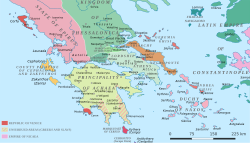Background

Following the capture of Constantinople by the Fourth Crusade in April 1204, the establishment of the Latin Empire on the ruins of the Byzantine Empire and the treaty of partition of the latter's lands among the Crusader leaders, most of Greece was taken over relatively quickly by the Crusaders. Boniface of Montferrat established the Kingdom of Thessalonica in northern and eastern Greece, and gave fiefs to his followers in Thessaly and Central Greece. Further south, the Peloponnese was conquered by William of Champlitte and Geoffrey I of Villehardouin, establishing the Principality of Achaea, under Thessalonica's suzerainty. Only Epirus remained in Greek hands, with Michael I Komnenos Doukas establishing a separate principality there. [1] [2]
Alongside their various fiefs and principalities, the Crusaders installed Roman Catholic prelates in the local Greek Orthodox sees; the pre-existing patterns of ecclesiastical organization were largely maintained, but the new clergy was soon riven by rivalries. As William Miller writes, "The organisation of the Church was a fruitful source of quarrels. [...] the primate of Achaea, a Frenchman, fretted at being placed under the jurisdiction of a Venetian patriarch, who had promised his government to appoint none but Venetians to archbishoprics. [...] His suffragans had inherited from their Greek predecessors time-honoured but tiresome quarrels as to the boundaries of their dioceses; the clergy disputed with the bishops, the Templars with the primate." [3] Many clerics, particularly French, soon left Greece for their homelands, while others were absentees and never visited their sees, and the behaviour of others differed little from that of mere adventurers out to make a fortune: the Latin Archbishop of Patras was suspended for financial mismanagement, and his counterpart of Corinth was dismissed and sent back to his monastery for misconduct. [4]
These problems were compounded by the hostile attitude shown by the Frankish princes themselves towards the clergy. Thus the baron of Patras carried the archbishop off to prison, cut off the nose of his bailli , and used the episcopal residence and the nearby church of St. Theodore as the basis for the Castle of Patras. In this he followed the example of his own master, Geoffrey of Villehardouin, who refused to recognize the traditional privileges of the church, pay the tithe or compel his subjects and feudatories to pay it, and forced the clergy to use the secular courts, rather than ecclesiastical tribunals. The lord of the Duchy of Athens, Otho de la Roche, followed a similar policy, and even obliged the clergy to pay the land tax, thereby depriving the Latin Archbishopric of Thebes of over two thirds of its pre-Frankish conquest revenue. Even in Venetian-held Modon, the local governor barred the Latin bishop from using the cathedral or even residing in the castle. [5]